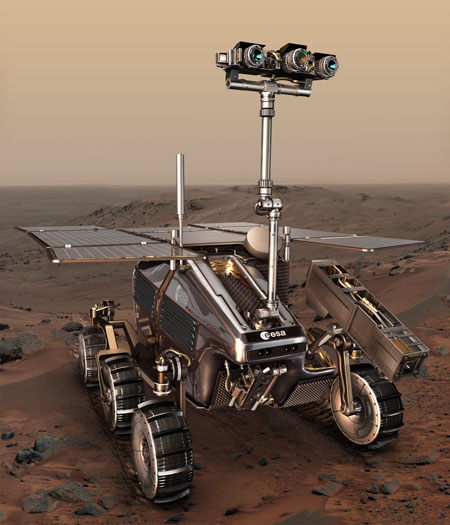NASA's Multi-Robot Planetary Exploration Plans

Multi-robot planetary exploration would be a complex affair,with humans working with a diverse team of mobile robots operating in a varietyof control modes. Aurora Flight Sciences, MIT?s Manned Vehicle Laboratory(MVL), and MIT Humans and Automation Laboratory (HAL) have just won a NASASmall-Business Technology Transfer Research proposal to develop a softwaresystem that performs command and control.
According to a press release issued by Aurora FlightSciences:
?'Aurora sees this as an opportunity to expand itsmulti-vehicle coordination capabilities into the realm of planetaryexploration. We view this project as a natural integration of our expertisein space systems and in tools for planning and coordinating autonomous teams,'said Dr. James Paduano, Autonomy Controls and Estimation Group Lead.
Mobile robots operating in teams will be instrumental inextending human reach in planetary exploration... However, communication delaysto remoterobot teams and/or the limited supervision that an astronaut can providemake it necessary for the robot team to perform coordinated tasks robustly andautonomously. To address this problem, Aurora and MIT will combine multi-agentplanning algorithms, human interfaces, and associated expertise into amulti-robot, human supervised system that can operate with long time delaysbetween human interactive inputs... "
The system will provide ground control user interfaces anddata management that:
- allows for interactive user control of the robot team in a time-delayed control environment
- maintains operator situational awareness, providing a human interface for setting up a task queue that can be autonomously executed with limited/no human interaction
- allows the multi-robot team to optimize task performance as geospatial, navigation and other sensor information is gathered, and
- is supported by recent algorithm and software developments in the military multi-vehicle control regime (including human interfaces).
Science fiction writers have long recognized the value ofhaving teams of planetary exploration robots that would cooperate with eachother and work with people in various control modes.
"'Look, that robot, DV-5, has six robots under it. Andnot just under it - they're part of it...'
Get the Space.com Newsletter
Breaking space news, the latest updates on rocket launches, skywatching events and more!
He watched the posturings of the robots on the visiplate.They were bronzy gleams of smooth motion against the shadowy crags of theairless asteroid. There was a marching formation now, and in their own dim bodylight, the rough-hewn walls of the mine tunnel swam past noiselessly, checkeredwith misty erratic blobs of shadow. They marched in unison, seven of them, withDave at the head. They wheeled and turned in macabre simultaneity; and meltedthrough changes of formation with the weird ease of chorus dancers in LunarBowl."
(The robot teamfrom IsaacAsimov's story Catch That Rabbit [1944])
If you're as interested in team robotics as NASA, don't missreading how the COTSScout: Team Building Robot works well with others, and this story about RoboticSafety Barrels: Smart Traffic Cones.
From Aurora Flight Sciences Wins NASA Contract for Multi-RobotPlanetary Exploration.
(This Science Fiction in the News story used withpermission of Technovelgy.com).
- New Video Robot Yo-Yo: NASA's Novel Axel Rover
- New Video - Spirit on Mars: NASA's Little Rover That Could
- Future of Mars Exploration: What's Next?
Join our Space Forums to keep talking space on the latest missions, night sky and more! And if you have a news tip, correction or comment, let us know at: community@space.com.
Bill Christensen is the founder and editor of Technovelgy, a website dedicated to cataloguing the inventions, technology and ideas of science fiction writers. Bill is a dedicated reader of science fiction with a passion about science and the history of ideas. For 10 years, he worked as writer creating technical documentation for large companies such as Ford, Unisys and Northern Telecom and currently works to found and maintain large websites. You can see Bill's latest project on Twitter.









